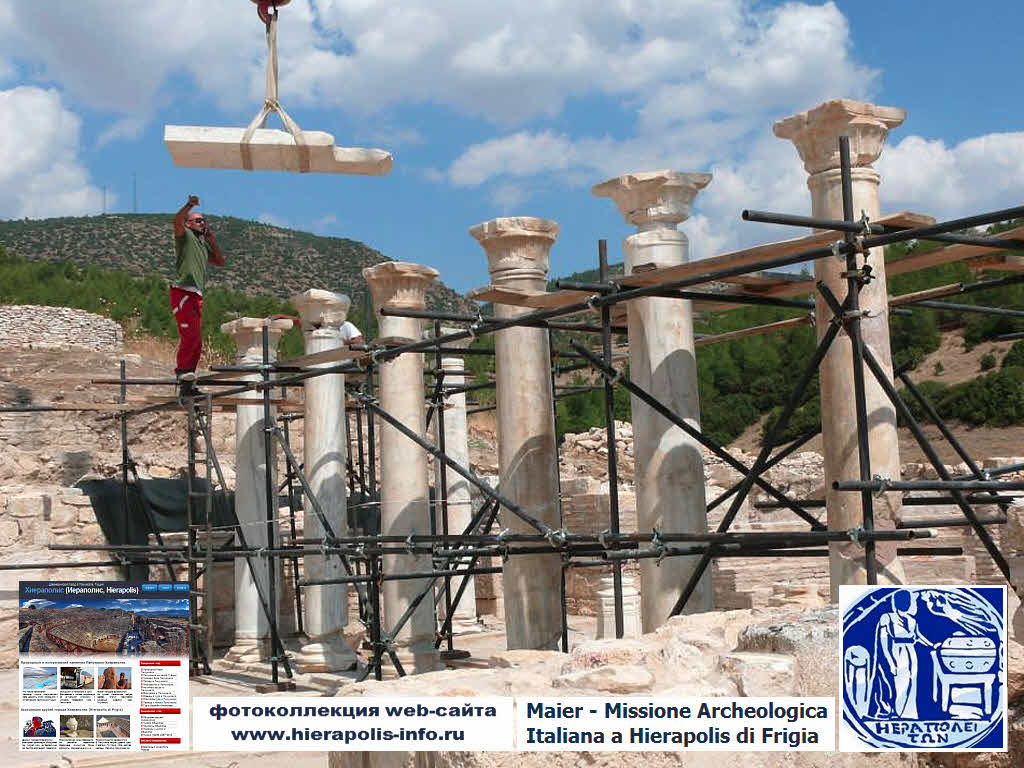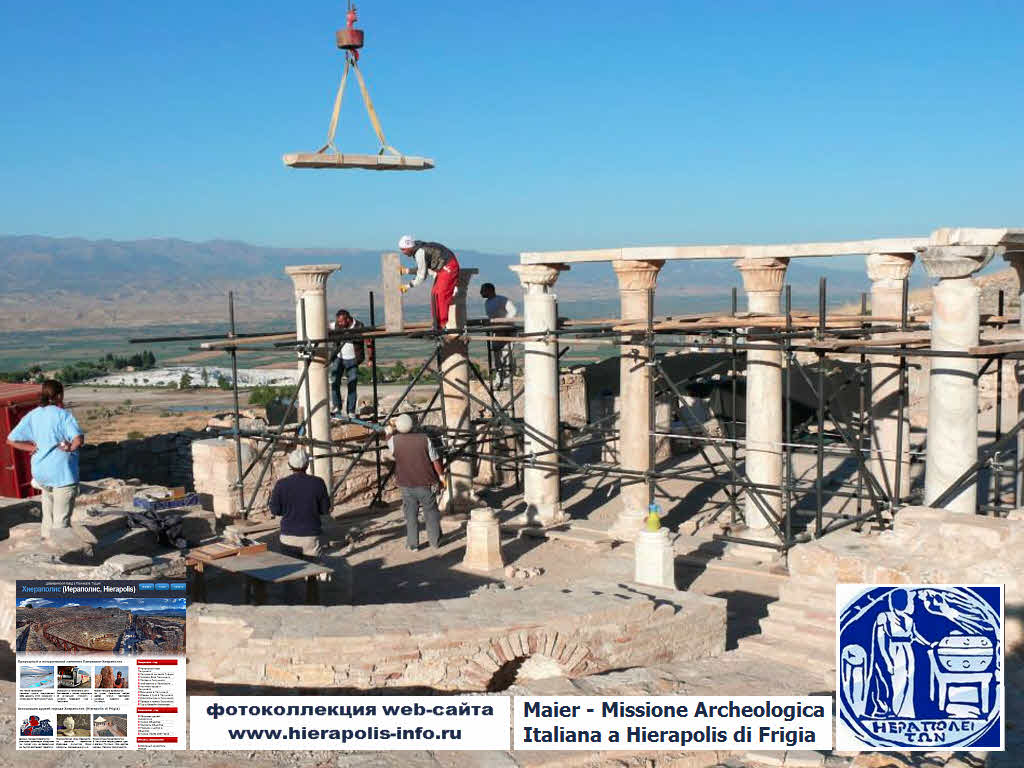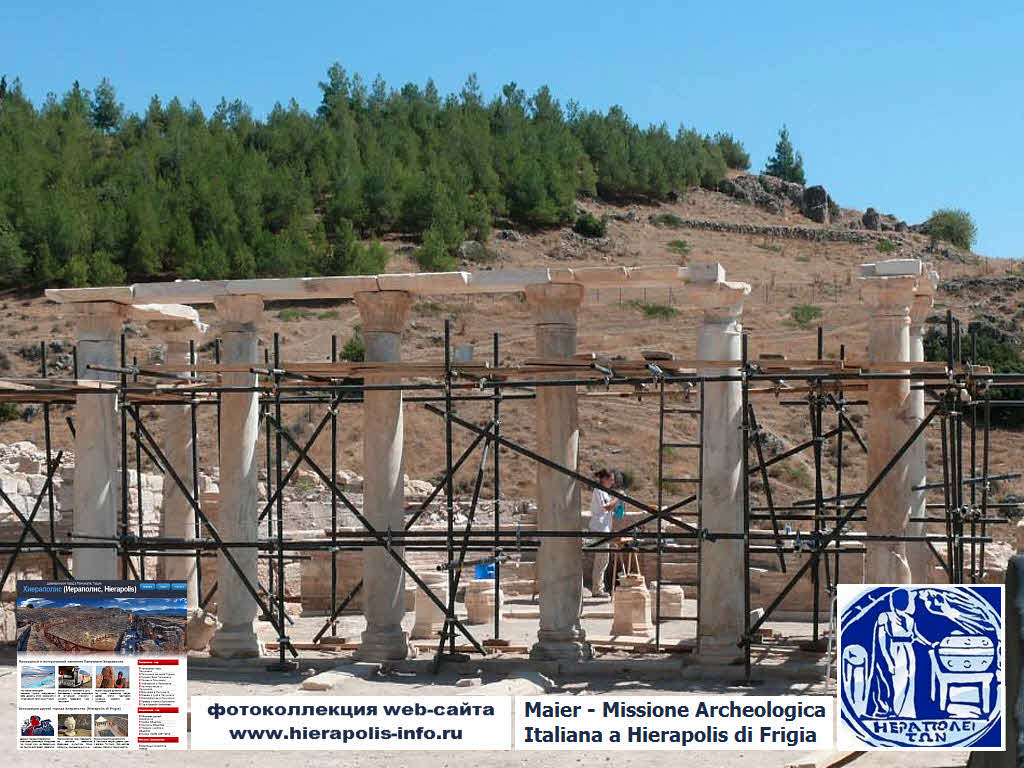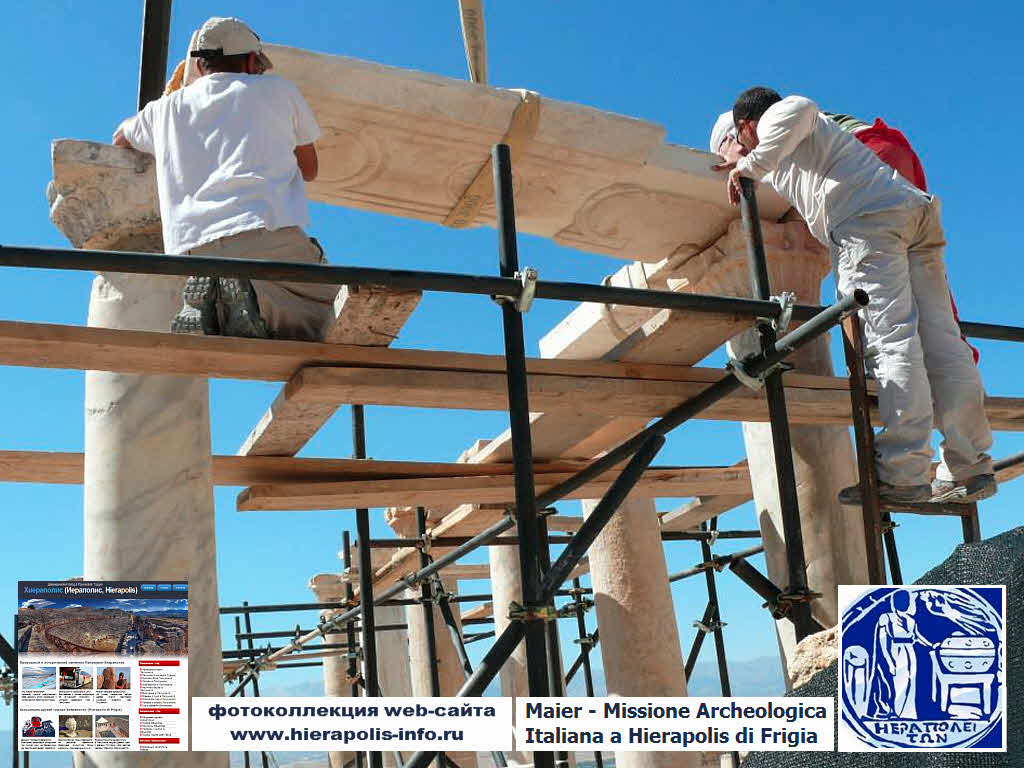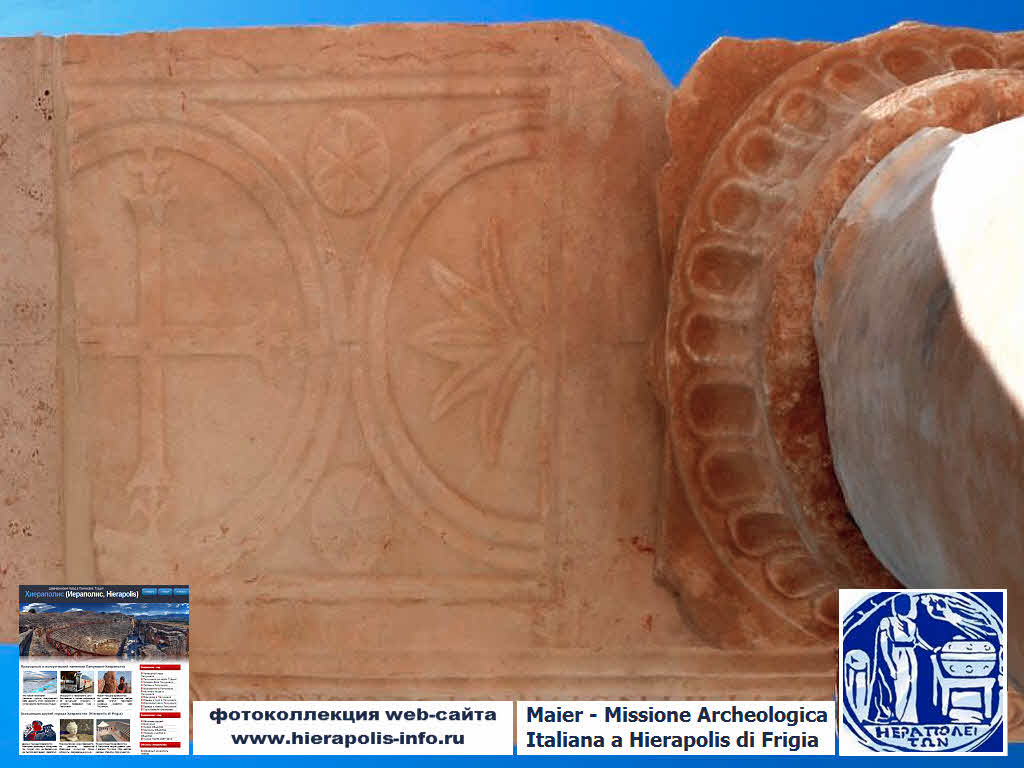In 2014, Italian archaeologists have established eight columns at the ruins of the
church of the Apostle
St. Philip on the excavation of the city of Hierapolis (Pamukkale, Turkey now).
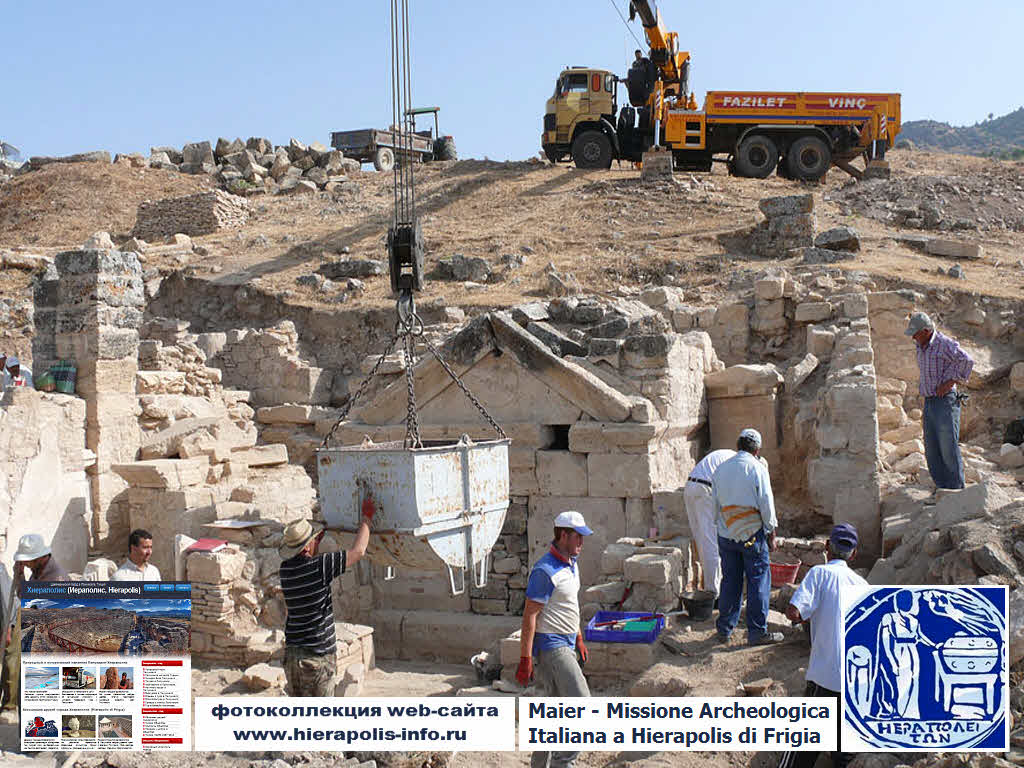
New monumental structure was opne on the map the contours of the ancient Hierapolis.
The Saint Philip was crucified on the cross in the 1st century AD not far from the hill of the victims.
The Saint Philip is one of the twelve apostles of Christ. A small temple (church) was reconstructed now by
MAIER team. An important feature is that the center of the eastern church wall was located before
the entrance to the
tomb
built with the disposal (grave) of St. Philip the Apostle.
It is well known that the tomb of St. Philip and the remains of a church were discovered in 2011-2012 (see
photo on the left side). The archaeologists (MAIER team) have cleared the hill and charch ruins.
They drawing up an action plan for partial reconstruction of church.
During this time, MAIER made public the many facts of detecting residues of the perimeter walls and
well-preserved altar of the temple, as well as a large number of marble columns, capitals, architraves.
Finally, the Italian archaeologists have put a fat point in the debate about the original burial place of
the Apostle. Immediately after his death, Philip was buried in the tomb, little distinguishable from the
other tombs on the eastern necropolis of Hierapolis. After coming to power of the Byzantine emperors
(about 5-6 centuries AD) two new religious buildings it was constructed ih Hierapolis.
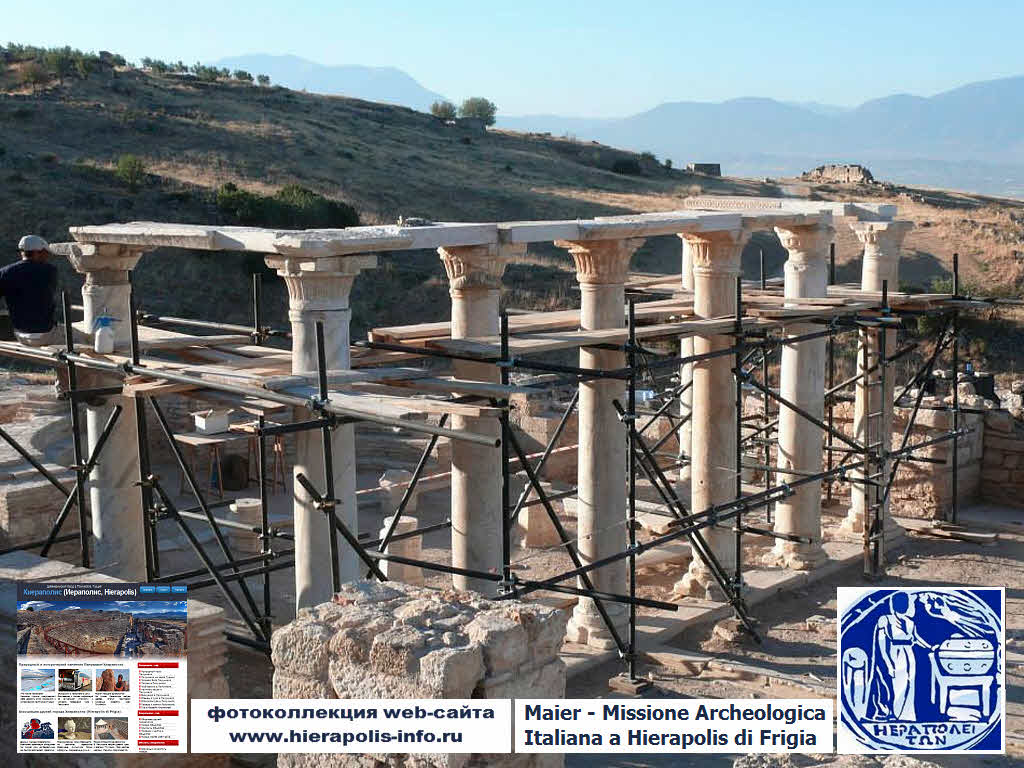
Concise church of St. Philip was constructed in the high side of a mountain, where the tomb was located.
Martirion was built in the place of execution - a horizontal platform of impressive sizes.
It was a monastery. The pilgrims lived here at long time coming.
Reconstruction of Church of St. Philip (2011-2015) has supported by the Kaplan Foundation (USA).
Many activities for the reconstruction of the church - the Basilica of St. Philip (Pamukkale, Turkey now)
have been done.
These included the cleaning of the original basilica floor tiles, leveling and
concreting of walls and remains of ASPs (traditional sandwich constructed of hewn stone travertine
tiles and clay deification), as well as the construction of the colonnade. The latter work includes
reconstruction of eight original marble columns and capitals. Architraves crowning colonnade,
"patterned", in other
words half of the plate have been made from scratch.
|
|
Indeed, small-thickness architrave plates was poorly preserved, probably after the earthquake of the 7th century,
they hit the ground and then were looted or re-used in the construction in the city.
On the surface of the plates are read distinctly Christian religious symbols.
But on one architrave plate perfectly preserved text in Greek, "God remembers me."
All of this is irrefutable evidence that this structure is a Christian church, and Hierapolis was an important
center of religious pilgrimage in the era of the Byzantine Empire.
Reconstructed church of St. Philip on the ruins of Hierapolis in Pamukkale, open to tourists now. Large information
boards installed in its territory to include pictures, 3d-models of buildings, brief background information.
|
Photos church of St. Philip in Hierapolis (Pamukkale)
 New monumental structure was opne on the map the contours of the ancient Hierapolis.
The Saint Philip was crucified on the cross in the 1st century AD not far from the hill of the victims.
The Saint Philip is one of the twelve apostles of Christ. A small temple (church) was reconstructed now by
MAIER team. An important feature is that the center of the eastern church wall was located before
the entrance to the tomb
built with the disposal (grave) of St. Philip the Apostle.
It is well known that the tomb of St. Philip and the remains of a church were discovered in 2011-2012 (see
photo on the left side). The archaeologists (MAIER team) have cleared the hill and charch ruins.
They drawing up an action plan for partial reconstruction of church.
During this time, MAIER made public the many facts of detecting residues of the perimeter walls and
well-preserved altar of the temple, as well as a large number of marble columns, capitals, architraves.
Finally, the Italian archaeologists have put a fat point in the debate about the original burial place of
the Apostle. Immediately after his death, Philip was buried in the tomb, little distinguishable from the
other tombs on the eastern necropolis of Hierapolis. After coming to power of the Byzantine emperors
(about 5-6 centuries AD) two new religious buildings it was constructed ih Hierapolis.
New monumental structure was opne on the map the contours of the ancient Hierapolis.
The Saint Philip was crucified on the cross in the 1st century AD not far from the hill of the victims.
The Saint Philip is one of the twelve apostles of Christ. A small temple (church) was reconstructed now by
MAIER team. An important feature is that the center of the eastern church wall was located before
the entrance to the tomb
built with the disposal (grave) of St. Philip the Apostle.
It is well known that the tomb of St. Philip and the remains of a church were discovered in 2011-2012 (see
photo on the left side). The archaeologists (MAIER team) have cleared the hill and charch ruins.
They drawing up an action plan for partial reconstruction of church.
During this time, MAIER made public the many facts of detecting residues of the perimeter walls and
well-preserved altar of the temple, as well as a large number of marble columns, capitals, architraves.
Finally, the Italian archaeologists have put a fat point in the debate about the original burial place of
the Apostle. Immediately after his death, Philip was buried in the tomb, little distinguishable from the
other tombs on the eastern necropolis of Hierapolis. After coming to power of the Byzantine emperors
(about 5-6 centuries AD) two new religious buildings it was constructed ih Hierapolis.
 Concise church of St. Philip was constructed in the high side of a mountain, where the tomb was located.
Martirion was built in the place of execution - a horizontal platform of impressive sizes.
It was a monastery. The pilgrims lived here at long time coming.
Reconstruction of Church of St. Philip (2011-2015) has supported by the Kaplan Foundation (USA).
Many activities for the reconstruction of the church - the Basilica of St. Philip (Pamukkale, Turkey now)
have been done.
These included the cleaning of the original basilica floor tiles, leveling and
concreting of walls and remains of ASPs (traditional sandwich constructed of hewn stone travertine
tiles and clay deification), as well as the construction of the colonnade. The latter work includes
reconstruction of eight original marble columns and capitals. Architraves crowning colonnade,
"patterned", in other
words half of the plate have been made from scratch.
Concise church of St. Philip was constructed in the high side of a mountain, where the tomb was located.
Martirion was built in the place of execution - a horizontal platform of impressive sizes.
It was a monastery. The pilgrims lived here at long time coming.
Reconstruction of Church of St. Philip (2011-2015) has supported by the Kaplan Foundation (USA).
Many activities for the reconstruction of the church - the Basilica of St. Philip (Pamukkale, Turkey now)
have been done.
These included the cleaning of the original basilica floor tiles, leveling and
concreting of walls and remains of ASPs (traditional sandwich constructed of hewn stone travertine
tiles and clay deification), as well as the construction of the colonnade. The latter work includes
reconstruction of eight original marble columns and capitals. Architraves crowning colonnade,
"patterned", in other
words half of the plate have been made from scratch.
 New monumental structure was opne on the map the contours of the ancient Hierapolis.
The Saint Philip was crucified on the cross in the 1st century AD not far from the hill of the victims.
The Saint Philip is one of the twelve apostles of Christ. A small temple (church) was reconstructed now by
MAIER team. An important feature is that the center of the eastern church wall was located before
the entrance to the tomb
built with the disposal (grave) of St. Philip the Apostle.
It is well known that the tomb of St. Philip and the remains of a church were discovered in 2011-2012 (see
photo on the left side). The archaeologists (MAIER team) have cleared the hill and charch ruins.
They drawing up an action plan for partial reconstruction of church.
During this time, MAIER made public the many facts of detecting residues of the perimeter walls and
well-preserved altar of the temple, as well as a large number of marble columns, capitals, architraves.
Finally, the Italian archaeologists have put a fat point in the debate about the original burial place of
the Apostle. Immediately after his death, Philip was buried in the tomb, little distinguishable from the
other tombs on the eastern necropolis of Hierapolis. After coming to power of the Byzantine emperors
(about 5-6 centuries AD) two new religious buildings it was constructed ih Hierapolis.
New monumental structure was opne on the map the contours of the ancient Hierapolis.
The Saint Philip was crucified on the cross in the 1st century AD not far from the hill of the victims.
The Saint Philip is one of the twelve apostles of Christ. A small temple (church) was reconstructed now by
MAIER team. An important feature is that the center of the eastern church wall was located before
the entrance to the tomb
built with the disposal (grave) of St. Philip the Apostle.
It is well known that the tomb of St. Philip and the remains of a church were discovered in 2011-2012 (see
photo on the left side). The archaeologists (MAIER team) have cleared the hill and charch ruins.
They drawing up an action plan for partial reconstruction of church.
During this time, MAIER made public the many facts of detecting residues of the perimeter walls and
well-preserved altar of the temple, as well as a large number of marble columns, capitals, architraves.
Finally, the Italian archaeologists have put a fat point in the debate about the original burial place of
the Apostle. Immediately after his death, Philip was buried in the tomb, little distinguishable from the
other tombs on the eastern necropolis of Hierapolis. After coming to power of the Byzantine emperors
(about 5-6 centuries AD) two new religious buildings it was constructed ih Hierapolis.
 Concise church of St. Philip was constructed in the high side of a mountain, where the tomb was located.
Martirion was built in the place of execution - a horizontal platform of impressive sizes.
It was a monastery. The pilgrims lived here at long time coming.
Reconstruction of Church of St. Philip (2011-2015) has supported by the Kaplan Foundation (USA).
Many activities for the reconstruction of the church - the Basilica of St. Philip (Pamukkale, Turkey now)
have been done.
These included the cleaning of the original basilica floor tiles, leveling and
concreting of walls and remains of ASPs (traditional sandwich constructed of hewn stone travertine
tiles and clay deification), as well as the construction of the colonnade. The latter work includes
reconstruction of eight original marble columns and capitals. Architraves crowning colonnade,
"patterned", in other
words half of the plate have been made from scratch.
Concise church of St. Philip was constructed in the high side of a mountain, where the tomb was located.
Martirion was built in the place of execution - a horizontal platform of impressive sizes.
It was a monastery. The pilgrims lived here at long time coming.
Reconstruction of Church of St. Philip (2011-2015) has supported by the Kaplan Foundation (USA).
Many activities for the reconstruction of the church - the Basilica of St. Philip (Pamukkale, Turkey now)
have been done.
These included the cleaning of the original basilica floor tiles, leveling and
concreting of walls and remains of ASPs (traditional sandwich constructed of hewn stone travertine
tiles and clay deification), as well as the construction of the colonnade. The latter work includes
reconstruction of eight original marble columns and capitals. Architraves crowning colonnade,
"patterned", in other
words half of the plate have been made from scratch.
